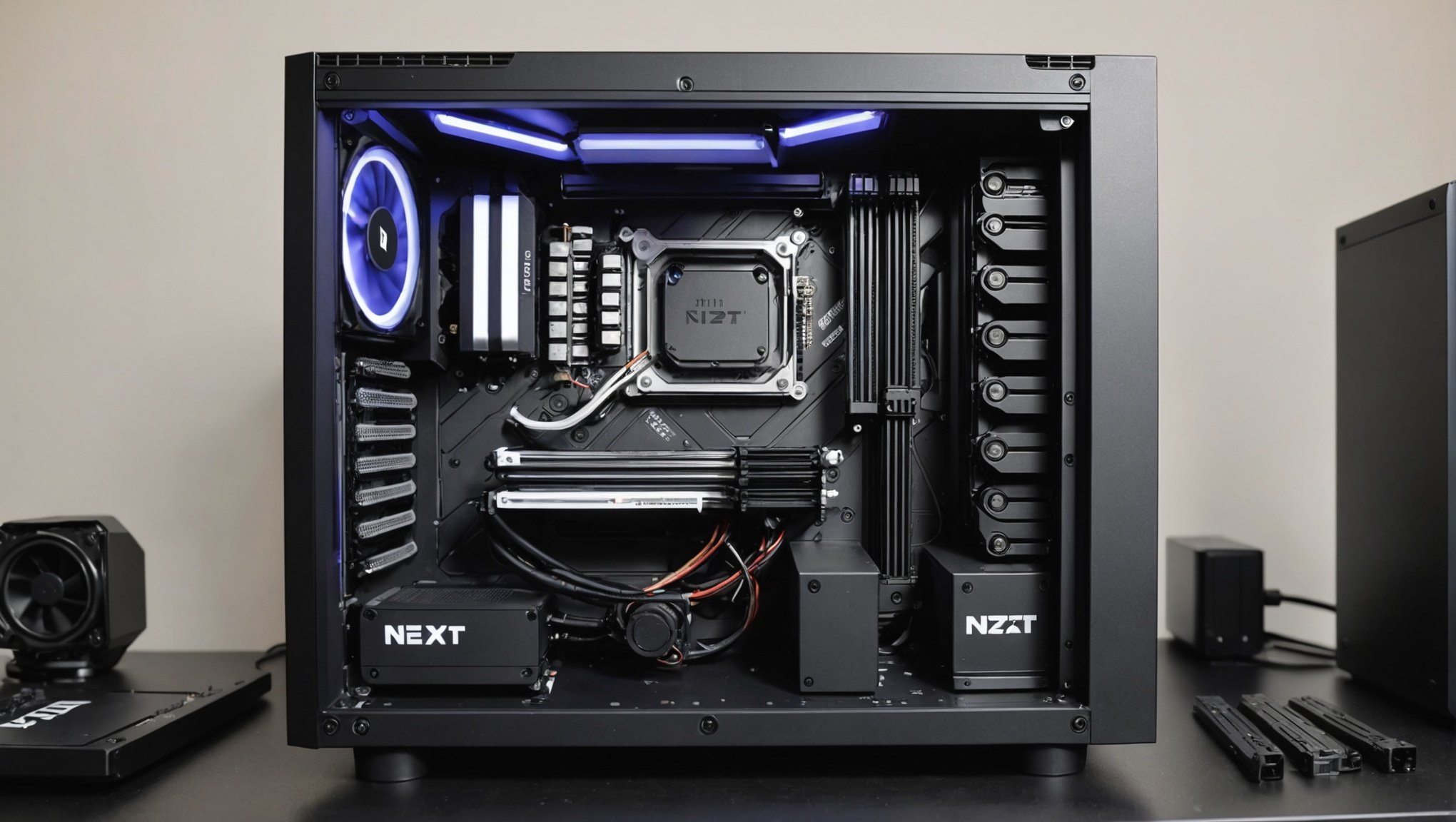Enhancing thermal performance in your NZXT H710i can significantly boost system efficiency and longevity. This step-by-step guide will walk you through the installation and configuration of a liquid cooling system, ensuring that your setup runs smoothly even under heavy loads. Whether you’re a seasoned PC builder or just starting out, mastering liquid cooling offers a strategic advantage in maintaining optimal temperatures. Follow along to transform your build into a performance powerhouse.
Overview of Liquid Cooling Systems
Liquid cooling systems are an advanced method of heat dissipation used in various applications, notably in high-performance computing. At their core, these systems consist of key components such as a pump, radiator, water block, and coolant. The pump circulates the coolant through the system, absorbing heat from the components and transferring it to the radiator, where it dissipates into the surrounding environment.
Also read : Mastering Secure and Efficient File Sharing: A Guide to Utilizing Synology DS720+ with Btrfs
The benefits of liquid cooling over traditional air cooling are significant. Liquid cooling provides superior thermal management by efficiently transporting heat away from critical components. This process allows for enhanced performance and stability, especially in environments requiring intensive computational power. Additionally, liquid cooling systems operate more quietly than air cooling systems, as they do not rely on multiple fans running at high speeds.
When discussing thermal performance improvements, liquid cooling systems excel by maintaining lower temperatures, thereby reducing the risk of overheating and prolonging the lifespan of components. This capability is particularly beneficial for overclocking, where components operate beyond their standard specifications. By effectively managing heat, liquid cooling systems ensure that high-performance devices run optimally, providing users with a reliable and efficient solution.
Also read : Top Security Tips for Establishing a Safe Remote Desktop Connection with Your Lenovo ThinkCentre M90n
Tools and Components Needed
Understanding the tools and components necessary for setting up a liquid cooling system is crucial for a successful installation. For those using an NZXT H710i case, ensuring compatibility with parts is essential.
Essential Tools for Installation
To start, gather the following liquid cooling installation tools:
- Screwdrivers (various sizes)
- Tubing cutter
- Thermal paste applicator
These tools will aid in assembling and securing components efficiently.
Recommended Systems for NZXT H710i
When selecting a liquid cooling system compatible with the NZXT H710i, consider options like the NZXT Kraken series or Corsair Hydro series. These systems are known for their seamless integration and reliable performance within this case model.
Additional Components Required
Beyond the core system, additional components are necessary:
- Fittings: Ensure a secure connection between tubes and components.
- Tubes: Choose appropriate lengths and diameters to fit your setup.
- Coolant: Opt for a high-quality coolant to maintain system efficiency.
These elements work together to create an effective liquid cooling system, ensuring optimal thermal management and performance.
Preparing the NZXT H710i Case
Before diving into the NZXT H710i preparation, it's crucial to understand the steps involved in safely opening and setting up the case. Begin by removing the side panels with care to avoid damaging any components. This will provide access to the interior, allowing for a thorough inspection and preparation for the liquid cooling system installation.
Cable Management
Effective cable management is essential for a tidy and efficient setup. Organise all cables, securing them with ties or clips, to prevent obstruction during the installation process. This not only improves airflow but also makes future maintenance easier. A well-organised case enhances both aesthetics and functionality.
Optimal Placement
Identifying the optimal locations for the radiator and pump within the NZXT H710i is vital for efficient cooling. The top and front of the case are typically the best spots for radiator placement, as these areas provide maximum airflow. Ensure the pump is positioned close to the components that generate the most heat, facilitating effective heat transfer. By carefully planning these placements, you can maximise the cooling potential of your liquid cooling system, ensuring your setup runs smoothly and efficiently.
Installing the Liquid Cooling System
Embarking on the liquid cooling installation steps requires precision and patience. Begin with the radiator installation. Position the radiator in the optimal location identified during the preparation phase, typically at the top or front of the NZXT H710i case. Secure it using screws, ensuring it's firmly mounted to prevent vibrations.
Next, move to the pump and water block. Proper mounting techniques are crucial here. Align the water block with the CPU, applying thermal paste beforehand to enhance heat transfer. Secure the block with the provided hardware, ensuring even pressure across the surface.
With the radiator and water block in place, it's time to connect the tubing. Measure and cut the tubes to the required length, allowing for smooth curves without kinks. Attach the tubes to the fittings on both the radiator and pump. Ensure each connection is tight and leak-proof by using appropriate clamps or compression fittings.
Finally, fill the system with coolant, checking for leaks. This meticulous approach to installing a liquid cooling system will ensure efficient thermal management and system reliability.
Configuring the Cooling System
Achieving optimal liquid cooling configuration involves fine-tuning fan and pump settings to balance performance and noise. Adjust the fan speeds based on your system's workload. Higher speeds enhance cooling but increase noise, while lower speeds are quieter but may compromise thermal efficiency.
Fan and Pump Settings
To manage these settings, utilise software designed for temperature monitoring and adjustments. Many systems include proprietary software that allows for precise control over fan curves and pump speeds. This software provides real-time data, enabling users to make informed decisions about their cooling strategy.
Balancing Noise and Efficiency
Finding the perfect balance between noise levels and cooling efficiency is crucial. Here are some tips to achieve this balance:
- Gradual Fan Curves: Set fan speeds to increase gradually as temperatures rise, avoiding sudden noise spikes.
- Quiet Mode: Use pre-configured quiet modes for less demanding tasks to maintain a peaceful environment.
- Custom Profiles: Create custom profiles for different usage scenarios, such as gaming or heavy computing, to optimise performance and acoustics.
By carefully configuring your cooling system, you can ensure your components remain cool under pressure while maintaining a pleasant noise level.
Safety Precautions and Troubleshooting
Ensuring liquid cooling safety during installation is paramount. Always power down and unplug your system before starting. Wear an anti-static wrist strap to prevent electrostatic discharge, which can damage components. Ensure your workspace is dry and well-lit to avoid accidents.
Troubleshooting Tips
During setup, you may encounter common issues. Air bubbles in the system can impede coolant flow. To resolve this, gently tilt and tap the case to release trapped air. If leaks occur, immediately power down and inspect all connections. Tighten loose fittings and replace any damaged components.
Pump failure is another potential problem. If the pump isn't running, check the power connection and ensure it's receiving adequate voltage. Listen for unusual noises, as they can indicate a malfunction.
Preventative Maintenance
For long-term reliability, regular maintenance is crucial. Inspect the system every few months for signs of wear or leaks. Clean the radiator and fans to prevent dust accumulation, which can reduce cooling efficiency. Replace the coolant annually to maintain optimal performance. By following these troubleshooting tips and maintenance practices, you can ensure your liquid cooling system operates safely and efficiently.
Performance Benchmarks and Testing
Understanding liquid cooling performance through benchmark testing is essential for optimising your system. Benchmark tests provide a comprehensive overview of how well your cooling setup manages thermal output under various conditions.
Overview of Benchmarking
Benchmarking involves running specific software to simulate high workloads, allowing you to evaluate the thermal performance of your liquid cooling system. These tests help identify any potential areas for improvement, ensuring your system remains stable and efficient.
Recommended Software for Stress Testing
To accurately assess your cooling system, utilise software like Prime95 or AIDA64. These programs are designed for stress testing, pushing your components to their limits. By doing so, you can observe how effectively your liquid cooling setup dissipates heat during intense processing tasks.
Interpreting Results and Adjustments
Once testing is complete, interpret the results to determine if adjustments are necessary. Look for any temperature spikes or inconsistencies. If needed, adjust fan speeds or pump settings to enhance performance. Regularly conducting these tests ensures your system remains in peak condition, providing optimal cooling for demanding applications.
Benefits of Liquid Cooling Beyond Thermal Performance
Liquid cooling systems offer numerous benefits that extend beyond mere thermal management. Among these advantages is the significant aesthetic value they bring to computing setups. Liquid cooling allows for enhanced customisation options, enabling users to personalise their systems with coloured coolants, illuminated tubing, and unique water block designs. This customisation not only adds visual appeal but also allows users to express their personal style.
Another crucial benefit of liquid cooling is its positive impact on system longevity and component health. By maintaining lower operating temperatures, liquid cooling reduces thermal stress on components, which can prolong their lifespan. This is particularly beneficial for high-performance systems that are often pushed to their limits.
Moreover, liquid cooling systems excel in noise reduction compared to traditional air cooling methods. Since liquid cooling relies on fewer and quieter fans, it operates more silently, creating a more pleasant environment for users. This quiet operation is especially advantageous for those who require a tranquil workspace or gaming experience. By offering these additional benefits, liquid cooling systems provide users with a comprehensive solution that enhances both the performance and aesthetics of their computing environment.











